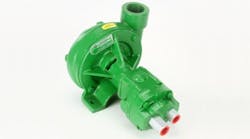Hydrostatic drives are certainly commonplace in off-highway equipment. For one thing, the versatility of hydraulics allows for controlling speed, torque, and power to closely match immediate needs of the application. Of course, hydraulic motors, cylinders and rotary actuators are powerful and compact, giving them a much higher power density than other forms for power transmission. Hydraulics doesn’t just provide the most practical form of power transmission for offhighway equipment — in many cases it is the only solution.
Hydraulics also allows high ground clearances because you don’t need to run drive shafts to wheels or differentials. And hydraulics also can deliver high torque, which is essential for driving large-diameter wheels up hills, through mud, and sometimes both.
But hydraulics is even more at home powering implements. No other form of power transmission even comes close to matching the high force and precise control of linear motion from hydraulic cylinders. Cylinders, of course, are widely used for pivoting motion needed for steering, lifting booms and buckets, and opening and closing grapples.
When a wider range of pivoting motion is needed, hydraulic rotary actuators can deliver extremely high torque from a surprisingly small package for rotational motion to 360° and well beyond. Of course, when the application calls for rotational motion, any of several designs of hydraulic motors may fit the bill.
A prime example of a machine taking full advantage of the many benefits is the Case IH Patriot 3330 sprayer from CNH America LLC. The Patriot 3330 is powered by a 6.7-l Tier III diesel engine rated 250 hp @ 2200 rpm. The engine drives a pair of variabledisplacement, axial piston pumps, which, in turn, each feed a pair of variable- displacement, axial-piston motors. The two pumps and four motors make up a dual hydrostatic four-wheel drive. The hydrostatic drive provides the high torque needed to drive the large diameter wheels through mud and up inclines.
The driver controls speed through a potentiometer. An electronic control senses the signal from the potentiometer and regulates pilot pressure of electrohydraulic valves, which controls displacement of the hydrostatic pumps. The vehicle starts from rest with the pumps at minimum displacement and the motors at maximum displacement. This provides maximum torque and minimum speed for starting.
The circuit is set up so that the motors remain at maximum displacement until the pumps reach their maximum displacement. When this occurs, pilot pressure then causes the motors’ displacement to decrease. Maximum speed of 30 mph is achieved when the motors reach minimum displacement with the pumps at maximum displacement.
It’s all in the hydraulics
But the extensive use of hydraulics doesn’t end there. In addition to the dual hydrostatic pumps, the hydraulic system also consists of a tandem pump mounted to the rear of each hydrostatic pump. One of these tandem pumps also features variable displacement and provides hydraulic power for steering and to drive the multiple cylinders for raising, lowering, pivoting, and extending the vehicle’s massive booms containing multiple spray nozzles for applying chemicals.
This pump also provides hydraulic power for adjustable wheel tracking. Wheel track can be adjusted from 120 to 157 in. apart, which allows the Patriot 3330 to be used on a much wider variety of crops than a sprayer with a fixed track. Hydraulics lets the operator adjust the track from within the cab, and manual stops are provided at 1-in increments. And because no drive shafts are needed, the 3330 has an impressive ground clearance of 52 in.
Hydraulics packs a powerful punch
The second tandem-mounted pump is used for getting the particular liquid chemical to be applied from a 55-gal tank to the applicator nozzles on the booms. This is accomplished by a centrifugal pump driven by a hydraulic motor that delivers fertilizer, herbicide, pesticide, or other required solution to the spray nozzles. The modular motorpump package is provided by Ace Pump Corp., Memphis. Ace’s pumps can be driven by hydraulic motor, electric motor, gasoline engine, a vehicle’s belt drive or PTO, or even compressed air when the application calls for a diaphragm pump.
As can be seen in the photo, the hydraulic motor is smaller than the centrifugal pump it drives. Not so with the electric motor or gasoline engine, each of which is two or three times the size of the pump or more — thus adding considerable size and weight to the package.
Because most off-highway equipment already makes extensive use of hydraulics, it stands to reason that tapping into a machine’s existing hydraulic system would be the most practical method of powering a pump for dispensing pesticides, herbicides, fertilizers, and other liquids.
Ace Pump recently partnered with Case IH to supply spray pumps for Patriot 3330 self-propelled sprayers. The spray pump is the heart of any modern sprayer, so long, trouble-free operation is imperative for today’s farmers and custom applicators. Until recently, Case IH used a constant-flow hydraulic system, so the centrifugal pump always ran at full speed.
On the newer system, however, centrifugal pump speed is regulated by routing any unneeded flow from the system’s hydraulic motor back to the system’s hydraulic reservoir. Granted, in this setup any unused power from the hydraulic pump is wasted. However, driving the centrifugal pump at variable speed still saves considerable energy.
Ace does offer even more energyefficient alternatives, but primarily provides a pumping system that best suits the specifications of the hydraulic design. For example, a variabledisplacement pump could have been used in this application to transmit only enough hydraulic power to meet demand of the centrifugal pump.
The Patriot 3330 regulates oil flow to the hydraulic motor based on demands of the sprayer. The variable speed feature of the drive improves component life by reducing the duty cycle of the centrifugal pump during low flow demand. The overall efficiency also increases because the pump only supplies the needed flow without excess bypass from the centrifugal pump.
Hydraulic motor reliability was improved by implementing the following changes:
• A case drain was incorporated to reduce pressure in its seal area.
• A perforated spacer was added between the motor bearing and high pressure shaft seal to improve oil flow.
• Internal motor venting was modified to promote oil flow in the seal area for enhanced cooling and lubrication.
The combination of the variableflow hydraulic system and motor improvements has reduced warranty claims and improved the reliability of the most critical sprayer component.
More than just fertilizer
Ace Pump offers a wide range of hydraulic motor driven centrifugal pumps for mobile equipment applications. Its close-coupled design provides a lightweight and compact package that can easily be installed. Pump characteristics can be customized for virtually any application, including pump materials, seal options, motor sizes, mounting configurations, etc.
All Ace hydraulic motors include a high-pressure shaft seal, reverse check valve, integrated anti-cavitation check, and needle valve bypass for open-center systems.
For more information on Ace pump drives, call (800) 843-2293, e-mail [email protected], or visit www.acepumps.com.
Click here to watch a demonstration video on Patriot spayers.
Keeping cylinder motion synchronizedIn addition to its centrifugal pump drive, another innovation in Case IH’s Patriot 3330 is the use of rephasing cylinders for positioning its sprayer booms — which can each be 90-ft long. The rephasing cylinders are used for synchronizing cylinder motion so that both booms move at the same speed. When appropriate, rephasing cylinders can be a simple, and cost effective alternative to other techniques. A rephasing cylinder is a standard hydraulic cylinder with the addition of one important feature — built-in orifices that provide passageways for fluid to hydraulically resynchronize cylinder motion if they come out of synchronization. These orifices can be on the cap end of the cylinder, the rod end, or both. Different methods exist to accomplish this function, but the orifice permits a small amount of hydraulic fluid to bypass the cylinder piston in the fully retracted or fully extended position. This make-up fluid allows the cylinders to rephase (synchronize) themselves, if necessary, during operation. Rephasing cylinders are typically used in one of two operating modes: series or parallel. Series mode — In this mode, the bore and rod diameters of the cylinders are of a size such that all cylinders extend or retract an equal distance when fluid flows into the first or last cylinder in the series. This type of circuit has a wide range of functions on many different types of machines. Parallel mode — Here, the bores and rod diameters of the two cylinders are the same. Therefore, when fluid enters the cap end of the first cylinder, its rod will extend the same amount as the cylinder’s rod retracts. Similarly, the first cylinder’s rod will retract the same amount as the other cylinder’s rod extends when fluid enters its cap end. This type of circuit is typically used for the steering function on off-highway equipment. Click here more information on rephasing cylinders for synchronized linear motion. |



